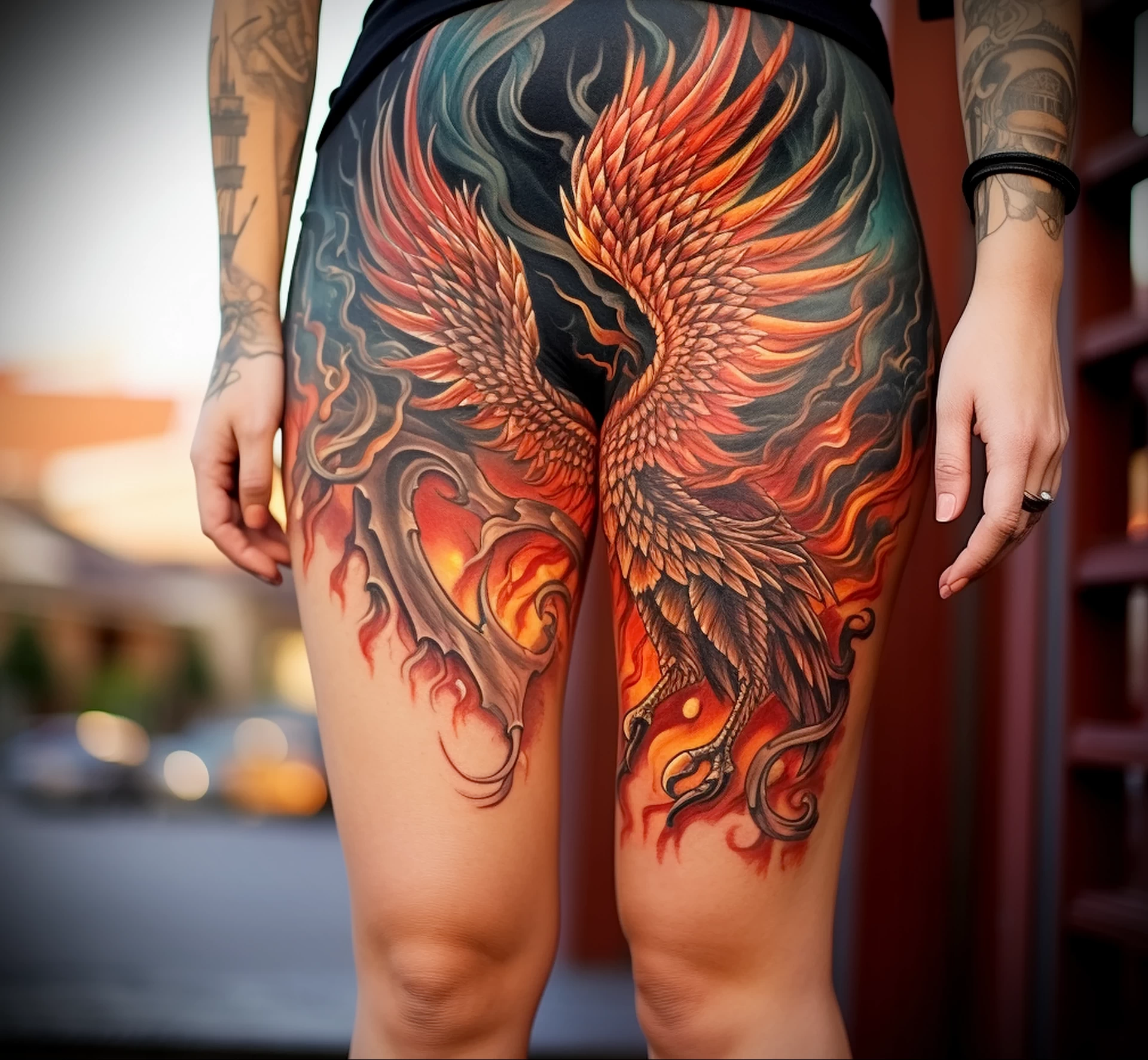Is it considered safe to get tattoos during menstruation? This question often sparks debates and myths among tattoo enthusiasts. In our new article, we delve into how the menstrual cycle can influence your decision to get a tattoo and provide detailed guidance on the specific care considerations for healthy healing. Dermatologists, gynecologists, and professional tattoo artists share their opinions and advice to help you make an informed choice. Dive into the world of tattoos with us and learn everything you need to know about getting tattoos on “special days.”
Tattoos During Menstruation: Safe or Not?
Tattoos have long ceased to be a marginal phenomenon and have become one of the popular ways of self-expression in modern society. Their history spans thousands of years, and over time, tattoos have undergone many transformations—from ancient rituals and signs of belonging to a specific group to means of individuality and art. Today, people of all ages, social statuses, and professions choose tattoos, each imbuing their body art with unique meanings.
However, there are several questions related to the tattooing process that don’t always have clear answers. One such question is whether it’s possible to get tattoos during menstruation. The menstrual cycle is a complex physiological process that can affect various aspects of a woman’s health, including pain sensitivity, immune responses, and wound healing speed. This raises concerns and assumptions about how menstruation can impact the tattooing process and subsequent healing. We’ll try to address this issue, relying on medical facts and expert opinions, to provide readers with comprehensive information to make an informed decision.
Key Aspects of the Menstrual Cycle
The menstrual cycle is a natural part of the female reproductive system, involving regular physiological changes in the body aimed at preparing for possible pregnancy. Typically lasting 28 days on average, although variations are allowed, it begins on the first day of menstruation and consists of several phases: the follicular, ovulatory, and luteal phases.
During the follicular phase, estrogen levels rise, stimulating the development of follicles in the ovaries. One of these follicles will become dominant and continue to mature. The ovulatory phase is characterized by the release of an egg from the mature follicle—a process known as ovulation. In the luteal phase, the structure formed after ovulation, called the corpus luteum, produces progesterone to support potential pregnancy.
During menstruation, women may experience various changes, including hormonal fluctuations that affect not only their physical condition but also their mood. Estrogen and progesterone levels fluctuate, which can affect pain thresholds, skin elasticity, and susceptibility to inflammation and infections. Additionally, for many women, menstruation is associated with discomfort and painful sensations, such as cramps and lower abdominal heaviness, caused by uterine contractions for endometrial shedding.
These changes and sensations are important to consider when planning any procedures that involve penetrating the skin barrier, including tattooing. The extent to which the menstrual cycle affects the tattoo healing process and pain sensations during tattooing can vary from woman to woman, making this question worthy of deeper exploration.
The Tattooing Process
Tattooing is a delicate and technically complex process that requires precision and knowledge. It begins with a consultation between the client and the artist, during which the design, size, tattoo placement, and potential risks are discussed. After selecting the design and preparing the skin, the actual process begins: the artist inserts ink into the skin using a specialized tattoo machine equipped with one or multiple needles. These needles oscillate at a frequency of 50 to 3000 times per minute, penetrating the epidermis and reaching the dermis to a depth of about one millimeter.
Proper skin care before and after tattooing is crucial for healing and the quality of the final artwork. Before the procedure, the skin needs to be cleansed and possibly treated with an antiseptic to prevent infection. After creating the tattoo, the artist applies a sterile bandage to the area, which helps protect the wound from bacteria and collects excess ink and blood.
During the first few days after the procedure, the skin may become red, swollen, and painful. It’s important to follow the tattoo artist’s instructions for care, including changing the bandage frequently, applying antibacterial ointments, and avoiding direct sunlight. Full healing typically occurs within 2-4 weeks, although this can vary depending on the tattoo’s size, skin type, and the client’s overall health.
In conclusion, the tattooing process is not just an artistic act but also a medical procedure that requires a responsible approach and proper care before and after its execution.
The Impact of Menstruation on Tattoo Application
The menstrual cycle has a multifaceted effect on a woman’s body, particularly on the hormonal balance, which can influence the tattoo healing process. Hormones such as estrogen and progesterone are directly related to skin regeneration, inflammatory processes, and pain sensitivity. During menstruation, the levels of these hormones fluctuate, which theoretically could slow down the healing process or increase the likelihood of inflammation. It’s important to emphasize that the body’s response is individual, and some women may experience these changes more intensely than others.
Besides the potential impact on healing, menstruation can increase skin sensitivity, making the tattooing process more painful. This is because a woman’s pain threshold can be lower during the menstrual cycle. Therefore, a procedure that is normally perceived as a slight irritation or discomfort can become significantly more painful during menstruation.
Increased pain sensitivity combined with hormonal changes requires a more attentive and cautious approach to tattooing during menstruation. Tattoo artists and clients should be aware of these factors when planning a session to maximize comfort and safety of the procedure. Despite the lack of strict medical contraindications, these aspects can significantly affect the tattooing experience and subsequent care.
Opinions of Specialists: Dermatologists, Gynecologists, and Tattoo Artists
In the article dedicated to the topic of the influence of menstruation on tattoo application, the opinions of qualified specialists play a key role. Dermatologists, in particular, emphasize that hormonal fluctuations during the menstrual cycle can affect the skin’s regenerative abilities and its response to inflammation. They caution that during this period, the skin may be more vulnerable to infections and trauma, which could potentially lead to a more prolonged and complex healing process.
Gynecologists focus on the individuality of the menstrual cycle for each woman, noting that some may experience increased pain and discomfort, while others may have less pronounced symptoms. They may also point to the possible influence of menstruation on overall well-being and stress resistance, which should be considered when planning a tattoo session.
Tattoo artists, based on their experience, often share observations that some clients during menstruation indeed show increased sensitivity to the procedure. They can confirm that for some clients the healing process is slower during menstruation, and skin reactions—such as redness or swelling—are more pronounced. Experienced artists may recommend postponing tattooing until after menstruation to minimize the risk of complications and enhance the client’s comfort during the procedure.
Thus, the combination of medical and practical opinions underscores the need for an individual approach to the issue of tattooing during menstruation. Experts agree that, despite the lack of clear contraindications, each woman should consider her physiological features and the possible impact of the menstrual cycle on the tattooing and healing process.
Recommendations and Contraindications
When considering the question of getting tattoos during menstruation, specialists provide a number of recommendations and point out potential contraindications. They advise clients to be attentive to their body and heed its signals. In case of strong pain sensations during menstruation, it may be recommended to postpone the session until they subside, to ensure greater comfort during the procedure.
Dermatologists suggest paying special attention to skin care before and after tattooing. Moisture content and hydration of the skin can contribute to better healing, so the use of moisturizing creams is recommended both before and after the procedure. However, one should avoid using products that contain active chemical substances that may cause irritation.
It’s also important to avoid alcohol consumption and certain medications, such as aspirin, which can increase bleeding during the procedure, complicating the work of the tattoo artist and potentially negatively affecting the healing process. In case of doubt, always consult a doctor regarding the intake of any medications before tattooing.
Tattoo artists, in turn, advise having a preliminary meeting to discuss all nuances and prepare for the procedure. They may offer to conduct a skin sensitivity test to assess the reaction to the inks and the tattooing process itself.
Contraindications for tattooing during menstruation may include any skin diseases, allergic reactions to the paint components, or individual intolerance to pain. If a client has chronic diseases, it’s important to discuss this with the artist and, if necessary, with a doctor.
The recommendations of specialists are general in nature, and when making a decision about getting a tattoo during menstruation, the individual characteristics of each woman should be considered. Communication with the artist and doctor will help minimize risks and ensure comfort and safety during the procedure and the healing period.
What Women Say About Getting Tattoos at Different Stages of the Menstrual Cycle
In a study on the impact of the menstrual cycle on the application and healing of tattoos, several interviews were conducted with women who had undergone the tattooing process at various phases of their cycle. These conversations revealed personal observations and experiences that may be valuable to those considering getting a tattoo during menstruation.
One participant, Anna, reported getting a tattoo in the middle of her menstrual cycle and did not notice any differences in the healing process compared to her previous experiences. She mentioned that she followed all of the tattoo artist’s aftercare recommendations and did not encounter increased sensitivity or pain.
Another respondent, Marina, shared that her experience of getting a tattoo on the first day of her period was less pleasant. She noted increased skin sensitivity and more pronounced pain during the procedure. Marina also indicated that the healing process took slightly longer than she expected and was accompanied by increased swelling.
Another woman, Ekaterina, reported that her tattoo, done a few days before the start of her period, healed without any particular issues, but during the first days of her menstruation, she felt an intensified itching in the area of the tattoo, which could have been related to hormonal changes in her body.
These personal stories underscore that every woman’s experience is unique, and there is no universal rule on how menstruation can affect the process of getting and healing a tattoo. They also illustrate the importance of considering individual characteristics and the possibility of closer interaction with the tattoo artist to ensure the best outcome and care for the tattoo.
One of the participants, Elena, shared her sensations and the specifics of caring for a tattoo received during menstruation. Elena described experiencing sharper pain during the tattooing compared to her previous experiences at other stages of the cycle. She also noticed that her skin seemed more sensitive and prone to redness.
Regarding tattoo aftercare, Elena stated that she adhered to all the tattoo artist’s recommendations: frequently changing the dressing, regularly applying special ointments, and avoiding direct sunlight. However, despite this, the healing process was slower than usual and was accompanied by increased itching and discomfort.
Elena emphasized that during the tattoo healing period, it’s important not only to follow the specialist’s advice but also to attentively listen to one’s body, avoiding possible overexertion and ensuring adequate hygiene and skin care. She also said that in case of any doubts or unusual reactions, one should not hesitate to consult a doctor.
This personal experience illustrates that even with strict adherence to all care rules, the body’s reaction to the tattooing procedure can be unpredictable, especially during the menstrual cycle. Therefore, individual attention to one’s own sensations and readiness for possible changes during the healing process are so important.
Tips and Recommendations
Experts emphasize that despite possible physiological inconveniences, proper preparation and meticulous care can minimize risks and discomfort.
Before getting a tattoo during menstruation, thorough preparation is recommended. Women are advised to get plenty of rest, provide themselves with a sufficient amount of nutritious food rich in vitamins and minerals, and drink plenty of water to maintain optimal skin hydration and overall well-being. It is also beneficial to avoid caffeine and alcohol the day before the procedure, as these substances can increase blood flow and skin sensitivity.
In terms of caring for the tattoo during menstruation, it’s important to consider increased sensitivity and a tendency for swelling. Specialists advise changing the protective dressing more often, especially in the first hours after the procedure, to prevent the accumulation of moisture and bacteria. The use of an antibacterial cream or ointment, recommended by the tattoo artist, will help speed up the healing process and reduce the risk of infection. It is important to avoid applying the ointment more thickly than necessary to allow the skin to breathe and heal properly.
Special attention should be paid to hygiene: wearing loose, breathable clothing is recommended to avoid irritating the tattooed area, and direct sunlight on the new tattoo should be avoided as it can cause inflammation and fading of the ink. During the healing period, it is also advisable to avoid visiting pools, saunas, and taking long baths.
These recommendations and tips serve as guidelines for women deciding to get a tattoo during menstruation and should be adapted considering the individual characteristics of each body. The key is to pay careful attention to one’s own body and to respond timely to any changes in the healing process.
Alternative Opinions and Myths
One common myth claims that it’s not possible to get tattoos during menstruation due to an increased risk of bleeding. However, medical experts refute this, pointing out that while menstruation is associated with a natural process of blood loss, it does not affect the blood’s tendency to coagulate in other parts of the body.
Another frequent myth is that tattoos can be more painful during menstruation. There is some basis for this claim, as some women may have a lower pain threshold during the menstrual cycle. However, this varies greatly from individual to individual, and not all women experience heightened pain sensations.
There is also a belief that tattoos heal worse if done during menstruation. There is no scientific evidence to support this myth. While hormonal fluctuations during the menstrual cycle can theoretically affect the healing process, there is no proof that these changes are significant enough to cause real issues with tattoo healing.
Another common misconception is that tattoos can affect the menstrual cycle. There is no scientific evidence that the tattoo application procedure can cause changes in hormonal balance or disrupt the cycle. The menstrual cycle is controlled by a complex system of hormones and interactions between the brain, ovaries, and uterus, and the external introduction of ink under the skin has no impact on it.
Tatufoto.com debunks these myths, relying on medical research and expert opinions, providing you with reasoned information for making informed decisions. We emphasize the importance of verified information and reject unfounded prejudices related to tattoos and menstruation.
Summary
Tatufoto.com has analyzed the opinions of medical specialists, the experience of tattoo artists, and personal stories of women. In conclusion, although menstruation introduces certain changes to the body that could potentially affect the tattooing process, there is no unequivocal evidence confirming the need to completely abstain from this procedure during the menstrual cycle.
It’s important to note that every woman is unique, and her reaction to getting a tattoo can differ significantly. In some cases, increased sensitivity and pain sensations, as well as a possible slowdown in the healing process, may be observed. However, these effects are not universal and may not be experienced by all.
The final recommendations for readers are as follows:
- Listen to your body and consider your individual sensations. If you experience heightened pain during menstruation, it might be worth postponing the procedure.
- Discuss all potential risks with your tattoo artist and inform them about the current phase of your menstrual cycle. An experienced professional will help choose the most suitable time for getting a tattoo.
- Prepare your skin for the procedure by hydrating it and providing proper care in the lead-up to the session. Avoid consuming alcohol, caffeine, and medications that affect blood coagulability.
- After getting the tattoo, carefully follow the aftercare instructions. Consult a doctor if necessary about the use of antibacterial and healing agents.
- If you experience unusual reactions, such as intensified itching, redness, or swelling, immediately seek medical attention.
Tatufoto.com emphasizes the importance of a thoughtful approach to the tattooing process and the need for thorough preparation and skin care, especially during menstruation. Following these recommendations will help minimize discomfort and ensure the best conditions for tattoo healing.
Photo examples of interesting tattoo designs on the bodies of beautiful girls (ideas for tattoos) from 07.11.2023
(Click to see more photos)





























